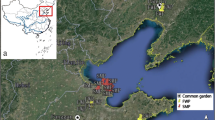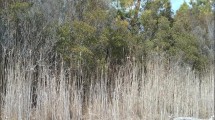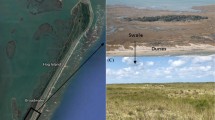Abstract
Salinization of coastal lands by sea-level rise means that information on the response of tropical tree species to salinity is urgently required to effectively manage coastal systems under future climatic scenarios. While salinity represents a major selective abiotic stress, little is known about the underlying mechanisms determining salinity tolerance in tropical trees. We examined salinity responses in seedlings of eight neotropical tree species from Panama, including four coastal species (Sterculia apetala, Pithecellobium ungi-cati, Terminalia cattapa, and Thespesia populnea) and four inland species (Minquartia guianensis, Apeiba membranaceae, Ochroma pyramidale, and Ormosia macrocalyx). Three-month-old seedlings of each species were subjected to increasing concentrations of 80, 120, 200, and 300 mM of either NaCl or KCl, while controls were irrigated with tap water. Overall, growth parameters such as leaf area (LA), leaf area ratio (LAR), stem height (SH), total dry mass (TDM), and relative growth rates (RGR) were reduced for all species as salinity increased, regardless of salt treatment. However, species from coastal environments outperformed inland species at high salinity. For example, seedlings of coastal species growing in 300 mM of NaCl or KCl, corresponding to ~ 50% seawater, survived and maintained LA, SH, and TDM between 50 and 90% compared with control plants. In contrast, inland species showed reductions in RGR, LA, and SH of up to 100%, at 120 mM of either salt. At the foliar level, K+ accumulation remained similar under NaCl and KCl treatments, and almost all species, with the exception of Minquartia from inland forests, maintained foliar Na+ accumulation across treatments when compared to controls. While species from coastal environments maintained foliar Cl− under NaCl and KCl treatments, inland species such as Ochroma showed up 95% increase in foliar Cl−. Our results suggest that salinity tolerance among tropical trees is predetermined by habitat association and ultimately by the ability of species to manage toxicity associated to foliar Na+ and Cl−. While the ecological implications of sea-level rise in coastal vegetation require further examination, is foreseeable that adaptation strategies in tropical shorelines consider the use of coastal species (i.e., reforestation) as the best tool to ameliorate the impact of increased salinity.





Similar content being viewed by others
References
Allen JA, Chambers JL, Stine M (1994) Prospects for increasing the salt tolerance of forest trees: a review. Tree Physiol 14:843–853
Blum A (2011) Plant water relations, plant stress and plant production. Plant Breed Water-Limited Environ 1:11–52
Buchanan BB, Balmer Y (2005) Redox regulation: a broadening horizon. Annu Rev Plant Biol 56:187–220
Casierra-Posada F (2006) Tolerancia de plantas de feijoa (Acca sellowiana [Berg] Burret) a la salinidad por NaCl. Agron Colomb 24:258–265
Condit R, Pérez R, Daguerre N (2010) Trees of Panama and Costa Rica, vol 1. Princeton University Press, Princeton
De Sedas A, Gonzalez Y, Winter K, Lopez OR (2019) Seedling responses to salinity of 26 neotropical tree species. AOB Plants. https://doi.org/10.1093/aobpla/plz062
Díaz-López L, Gimeno V, Lidón V, Simón I, Martínez V, García-Sánchez F (2012) The tolerance of Jatropha curcas seedlings to NaCl: an ecophysiological analysis. Plant Physiol Bioch 54:34–42
Duarte B, Santos D, Marques JC, Caçador I (2013) Ecophysiological adaptations of two halophytes to salt stress: Photosynthesis, PS II photochemistry and anti-oxidant feedback—Implications for resilience in climate change. Plant Physiol Bioch 67C:178–188
Eaton FM (1942) Toxicity and accumulation of chloride and Sulfate salts in plants. J Agricult Res 64:357–399
Fixen PE (1993) Crop responses to chloride. Adv Agron 50:107–150
Flowers TJ, Troke PF, Yeo AR (1977) The mechanism of salt tolerance in halophytes. Annu Rev of Plant Physiol 28:89–98
Flowers TJ, Yeo AR (1986) Ion relations of plants under drought and salinity. Funct Plant Biol 13:75–91
Flower TJ, Colmer TD (2008) Salinity tolerance in halophytes. New Phytol 179:945–963
Flowers TJ, Munns R, Colmer TD (2015) Sodium chloride toxicity and the cellular basis of salt tolerance in halophytes. Ann Bot 115:419–431
Fricke W, Peters WS (2002) The biophysics of leaf growth in salt-stressed Barley. A study at the cell level. Plant Physiol 129:374–388
Hughes TP, Baird AH, Bellwood DR, Card M, Connolly SR, Folke C, Grosberg R, Hoegh-Guldberg O, Jackson JBC, Kleypas J, Lough JM, Marshall P, Nystrom M, Palumbi SR, Pandolfi JM, Rosen B, Roughgarden J (2003) Climate change, human impacts, and the resilience of coral reef. Science 301:929–933
IPCC (2012) Field CB, Barros V, Stocker TF, Dahe Q, et al (eds) Managing the risks of extreme events and disasters to advance climate change adaptation. Cambridge University Press, Cambridge
IPCC (2014) Cambio climático 2014 Informe de síntesis Resumen Chapter para responsables de políticas. Chapter 4, Cambridge University Press. Cambridge
Kozlowski TT (1997) Responses of woody plants to flooding and salinity. Tree Physiol 17:490–490
Kumar-Parida A, Das AB (2005) Salt tolerance and salinity effects on plants: a review. Ecotox Environ Safe 60:324–349
Lambers H (1998) Photosynthesis, respiration, and long-distance transport. In: Lambers H, et al. (eds) Plant physiological ecology. Springer, New York
Lezcano JL, Lopez OR (2015) Historia natural de la vegetación costero-literal del istmo de Panamá. In: Rodríguez Mejía FA and O'Dea A (editors). Historia Natural del Istmo de Panamá. Chapter: 6. Publisher: Toppan Lee Fung, Secretaría Nacional de Ciencia Tecnología e Innovación (SENACYT), pp 83–101
Maathuis FJ, Ichida M, Sanders D, Schroeder JI (1997) Roles of higher plant K+ channels. Plant Physiol 114:1141–1149
Møller IS, Gilliham M, Jha D, Mayo GM, Roy SJ, Coates JC, Haseloff J, Tester M (2009) Shoot Na+ exclusion and increased salinity tolerance engineered by cell type-specific alteration of Na+ transport in Arabidopsis. Plant Cell 21:2163–2178
Munns R, Tester M (2008) Mechanisms of salinity tolerance. Annu Rev Plant Biol 59:651–681
Nelson G (1994) The trees of Florida. Pineapple Press, Sarasota, p 338
Nicholls RJ (2002) Analysis of global impacts of sea-level rise: a case study of floodin. Phys Chem Earth 27:1455–1466
Nicholls RJ, Lowe JA (2004) Benefits of mitigation of climate change for coastal areas. Glob Environ Chang 14:229–244
Ramos R, Lopez MJ, Benloch M (2004) Effect of NaCl and KCl salts on the growth and solute accumulation of halopyte Atriplex nummularia. Plant Soil 259:163–168
Ruiz D, Martínez V, Cerdá A (1997) Citrus response to salinity: growth and nutrient uptake. Tree Physiol 17:141–150
Sairam RK, Tyagi A (2004) Physiology and molecular biology of salinity stress tolerance in plants. Curr Sci 86:407–421
Setia R, Gottschalk P, Smith P, Marschner P, Baldock J, Setia D, Smith J (2012) Soil salinity decreases global soil organic carbon stocks. Sci Total Environ 465:267–272
Shabala S, Cuin TA (2008) Potassium transport and plant salt tolerance. Physiol Plant 133:651–659
Shekoofa A, Bijanzadeh E, Emam Y, Pessarakli M (2013) Effect of salt stress on respiration of various wheat lines/cultivars at early growth stages. J Plant Nutr 36:243–250
Sun D, Dickinson GR (1995) Salinity effects on tree growth, root distribution and transpiration of Casuarina cunninghamiana and Eucalyptus camaldulensis planted on a saline site in tropical north Australia. Forest Ecol Manag 77:127–138
Syvertsen JP, Garcia-Sanchez F (2014) Multiple abiotic stresses occurring with salinity stress in citrus. Environ Exper Bot 103:128–137
White PJ, Broadley MR (2001) Chloride in soils and its uptake and movement within the plant: a review. Ann Botany 88:967–988
Zhang HX, Blumwald E (2001) Transgenic salt-tolerant tomato plants accumulate salt in foliage but not in fruit. Nature Biotechnol 19:765–768
Zhang R, He J, Zhao Y, Peng Y, Fu L (2013) Another important factor of rising sea level: Soil Erosion. Clean: Soil, Air, Water 41:174–178
Acknowledgements
We would like to thank INDICASAT-AIP and the Smithsonian Tropical Research Institute for their logistical support to conduct this project in Gamboa, Panama. Yorlenis Gonzalez, Jorge Aranda, Milton Garcia, Aurelio Virgo and Mirna Samaniego provided valuable assistance to complete this work. We thank Dayana Agudo and Aleksandra Bielnicka for laboratory support. This research was financially possible through a SENACYT-IFARHU doctoral scholarship to ADS, an EFA11-015 grant and the support of the Sistema Nacional de Investigación (SNI) from the Secretaría Nacional de Ciencia Tecnología e Innovación (SENACYT) awarded to ORL.
Author information
Authors and Affiliations
Corresponding author
Additional information
Communicated by George Yan.
Publisher's Note
Springer Nature remains neutral with regard to jurisdictional claims in published maps and institutional affiliations.
Rights and permissions
About this article
Cite this article
De Sedas, A., Turner, B.L., Winter, K. et al. Salinity responses of inland and coastal neotropical trees species. Plant Ecol 221, 695–708 (2020). https://doi.org/10.1007/s11258-020-01043-y
Received:
Accepted:
Published:
Issue Date:
DOI: https://doi.org/10.1007/s11258-020-01043-y




